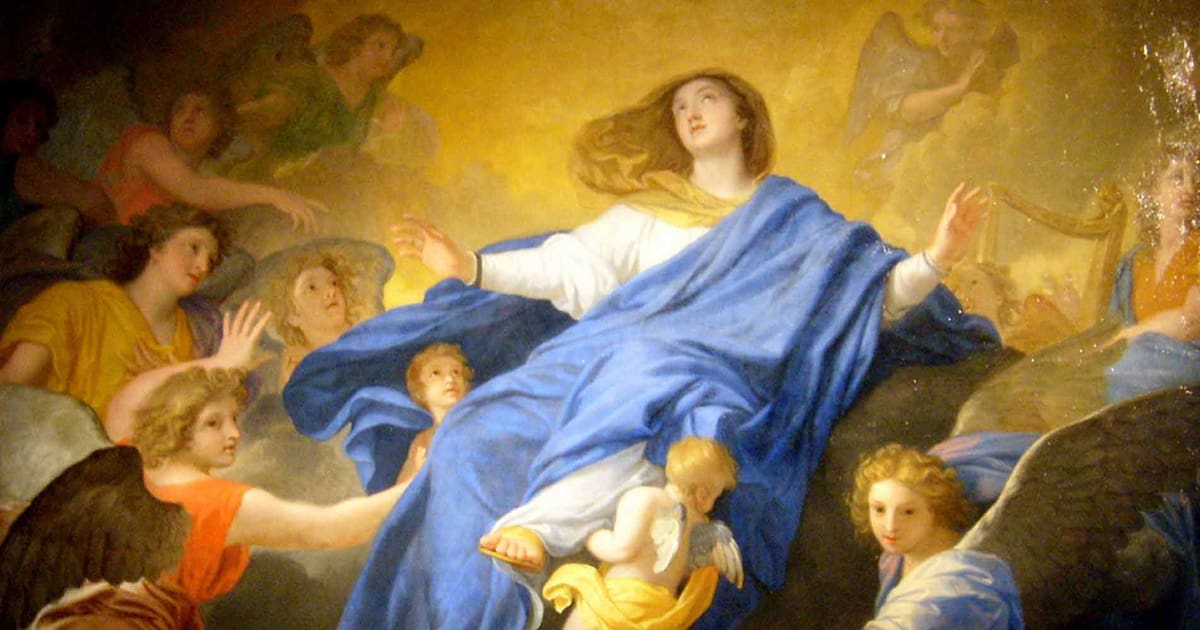The Church teaches that Mary’s Assumption anticipates the resurrection and is a sign of hope and comfort for us all. In her life, St. Elizabeth Ann Seton continually relied on this certain hope, in the sure knowledge of Mary’s presence in eternity, body and soul.
If November is the month when we contemplate death, August is the month of heaven. That’s because of the feast day of the Assumption of the Blessed Virgin Mary. Heaven is the message of this feast — and heaven is the hope of Christians who celebrate it.
St. Elizabeth Ann Seton embraced the doctrine of the Assumption of Mary and saw it as a sign of hope whenever she was faced with death. When Mother Seton wrote about the Assumption, she personalized it.
Catholics believe that the Virgin Mary, at the end of her life on earth, was taken up — “assumed” — body and soul into heaven. Death is the terrible separation of body from soul, and other souls are not reunited with their bodies until the final judgement. Though this dogma was only formally defined by Pope Pius XII in 1950, it was widely believed by the Church from its early centuries.
As St. John Damascene (676-749) put it: “It was fitting that she, who had kept her virginity intact in childbirth, should keep her own body free from all corruption even after death. … It was fitting that the spouse, whom the Father had taken to himself, should live in the divine mansions.”
St. Elizabeth Ann also explained how “fitting” the assumption was, but she went one more step. In a spiritual journal entry to Cecilia Seton, her sister-in-law, Elizabeth included these notes about the mystery:
“Assumption — Blessed Lord grant me that Humility and Love which has crowned her for Eternity. Happy happy Blessed Mother, you are reunited to Him whose absence was your desolation. Pity me; pray for me. It is my sweet consolation to think you are pleading for the wretched poor banished wanderer.”
For Mother Seton, not only was the Blessed Mother in heaven. She was in heaven for us. That’s because the doctrine of the Assumption is not just about the end of Mary’s life. It is also about the end of each of ours.
The Assumption is implicit in the Hail Mary prayer, the words that we speak to Mary far more than any others. The prayer ends with the petition, “pray for us, sinners, now and at the hour of our death.”
That request gets its special power from where Mary is—in heaven. The Church teaches that Mary’s assumption “anticipates the resurrection of all members of his [mystical] Body,” and so is a “sign of certain hope and comfort” for all of us.
This was the hope St. Elizabeth Ann turned to again and again when faced with death. For her, it was knowledge of the mere presence of Mary in heaven that brought comfort.
In one journal entry, on a stormy night spent with her daughter Rebecca, Elizabeth found herself unable to pray, but instead just held a picture of the Blessed Mother and a crucifix as her prayer.
“O my Mary, how tight I held my little picture as a mark of confidence in her prayers, who must be tenderly interested for souls so dearly purchased by her Son and the crucifix held up as a silent prayer which offers all his merits and sufferings as our only hope.”
When she kept journals recording the progress of the illnesses of those dear to her, Mother Seton often mentioned her daughters’ prayers to the Blessed Mother. In these, it is clear that those close to Elizabeth learned from her Marian devotion.
In one journal, she recounted how her daughter Anna Maria on her own sick bed rallied when she heard her mother pray the petition “Our Lady, refuge of sinners,” a title that grew from the Hail Mary’s “pray for us sinners.”
“Oh refuge of sinners pity me. I am a sinner, a miserable one,” Anna prayed, and, “Jesus Mary Joseph may my soul depart peacefully.” She learned from her earthly mother to have hope in her heavenly mother.
The hope St. Elizabeth Ann had in Mary is available to every Christian.
Heaven is not a reward for good behavior. It is the culmination of a lifetime of friendship, years spent conversing with Jesus and Mary that will end in an eternity continuing the conversation.
St. Elizabeth Ann’s hope in heaven was so complete because her relationship with the people there—Jesus and Mary—was so deep.
We can have the same conversation through the same means she used—praying the rosary, the Memorare prayer (a favorite of Mother Seton’s) and the Litany of Loreto. But more than reciting the prayers, Elizabeth rested in the sure knowledge of Mary’s presence in eternity, body and soul.
Because she was assumed into heaven, Mary is always equally available to each of us in a very real way. St. Elizabeth Ann Seton was certain of it, even when she faced her own death:
“If this be the way of death, nothing can be more peaceful and happy,” she wrote during one illness. “It seems as if our Lord or his blessed Mother stood continually by me, in a corporeal form, to comfort, cheer, and encourage me, in the different weary and tedious hours of pain.”
TOM HOOPES, author most recently of The Rosary of Saint John Paul II, is writer in residence at Benedictine College in Kansas, where he teaches. A former reporter in the Washington, D.C., area, he served as press secretary for the U.S. House Ways & Means Committee Chairman and spent 10 years as editor of the National Catholic Register newspaper and Faith & Family magazine. His work frequently appears in the Register, Aleteia, and Catholic Digest. He lives in Atchison, Kansas, with his wife, April, and has nine children.
Source: https://setonshrine.org/






0 Comments